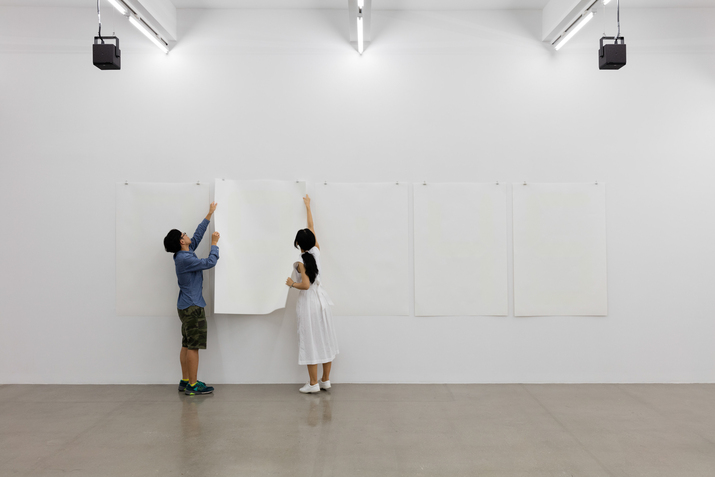-
From Current Issue
-
- Editor’s Letter Fire in the Heart
- Reviews I Gusti Ayu Kadek Murniasih
- Reviews 11th Seoul Mediacity Biennale: “One Escape at a Time”
- Dispatch Networked China
- One on One Monira Al Qadiri on Yukio Mishima
- Essays The rise of independent art spaces in pandemic-era Shanghai
- Features Tuan Andrew Nguyen
- Table of Contents
- Web Exclusives
- Archive
- Subscribe

R
E
V N
E
X
T
It was fitting that Philippe Parreno spoke little at the vernissage of his China debut, “Synchronicity” at Shanghai’s Rockbund Art Museum, in July. Indeed, his reserve and restraint matched the tone of an exhibition whose hierarchies of control—from the artist’s commandeering of the building’s mechanical functions, to outside meteorological conditions affecting the very visibility of some works—were compelling yet subtle enough to border the subliminal.
The show continued the French artist’s ongoing approach of “exhibition as medium,” recently witnessed at “Anywhen” for Tate Modern’s Turbine Hall and “Anywhere, Anywhere Out of the World” at Palais de Tokyo in Paris. For Parreno, that translates to overlapping encounters and sequences, which in Shanghai manifested as a holistic, immersive form that spanned sound, film, performance—and a palpable focus on light. Discussing Parreno’s almost theatrical approach, the exhibition’s curator and director of Rockbund Art Museum Larys Frogier explained, “Instead of visual art vocabulary, he talks of choreography. He will never say, ‘I need to install the exhibition.’ Instead, ‘I need to choreograph the exhibition.’”
In “Synchronicity,” Rockbund’s iconic architecture was at once protagonist and backdrop. Built in 1932 and formerly the home of the Royal Asiatic Society, the Art Deco building was restored by British architect David Chipperfield in 2010 to its current incarnation. For this exhibition, technical interventions, such as automated blinds and a rooftop heliostat reflecting an undulating trajectory of sunlight across the fourth floor gallery, lend the storied space an almost anthropomorphic quality: its windows “blink.” The edifice slumbers, and it reawakens.
It was not only the building that has been vivified. Setting the scene for the wider exhibition was animated manga character AnnLee. Periodic screenings of an adaptation of the 3D film Anywhere Out of the World (2000) were dramatically ushered on to a ceiling-height screen with the furious opening and closing of window blinds. The purple-haired, doe-eyed character was purchased from a Japanese studio by Parreno and fellow artist Pierre Huyghe in 1999. She cost 46,000 yen, AnnLee recalls, which was less than others in the studio’s catalog due to her relative lack of complexity and depth: “I was never designed to survive. It’s true,” she says. After “rescuing” AnnLee, Parreno and Huyghe invited collaborators to flesh out her character by way of the seminal project No Ghost Just a Shell (1999–2002). On concluding her monolog with these very same words, AnnLee raises a slight, somewhat impish smile. Her expression, however faint, casts a question that pervades the entire exhibition: Who, or what, is really in control here?
In this instance, it was a troupe of anonymous performers who controlled much of the audience’s experience. Parreno calls them dalang, or puppeteers in traditional Indonesian wayang theater. Each equipped with specially designed phone apps, it was they who determined when to activate AnnLee, and when those window blind squalls should happen. They sang too, and wandered the museum’s six floors quietly humming the film’s earworm refrain like a soundtrack to a movie.
The ceremonial performance underscored another device of control in “Synchronicity”: time. Like others on show here, it was only in the passing of time and the switching of lights that “Fade to Black” fully revealed itself, forcing the audience to fall into step and follow what is effectively a prescribed pace. Although Parreno may have presided over the sequences as a whole, with the dalangs empowered to determine certain elements, a heliostat on the museum’s roof relied on factors beyond everyone’s control. In bright sunlight, it cast a beam that traced a meandering, hypnotic course across the upstairs gallery floor. On an overcast day, the reflection may not have been visible.
The exhibition’s performative element came courtesy of artist and producer Asad Raza, who has also collaborated with Tino Sehgal. Some of the dalangs’ actions were more visible than others: on the third floor, for example, an iteration of “Fade to Black” (1995– ), an ongoing series of phosphorescent posters, saw performers studiously open and shut window blinds—manually, this time—and meticulously hang fluorescent screen prints. Periodically, the lights dramatically cut to reveal the prints as a glow-in-the-dark digital clock face, visible up to the time it displays to anchor the otherwise dream-like ritual firmly into reality.
“This way of controlling and not controlling is very interesting,” explained Frogier. “The exhibition is not only about light. In fact, one of the first things we talked about was shadows. For Parreno, maybe you see better, or in another way, when you do not see clearly. For him it was important to bring opacity, and different intensities of light, into the project.” Expanding on the exhibition’s erratic qualities, the curator said, “It is always a process of transformation. The montage or the combination is not only to make one picture, it’s really to activate changes; it will never be the same from one moment to another. That is really at the core of his work.”
In the context of Shanghai, where recent years have seen blockbuster exhibitions of gargantuan artworks in even bigger museums dominate the contemporary art scene, this eloquent, pared-down show presented an intriguing alternative. In replacing objects with experience, “Synchronicity” put Rockbund quite literally on a pedestal, with Parreno’s clever choreography casting the museum in an enchanting light.
Philippe Parreno’s “Synchronicity” is on view at Rockbund Art Museum, Shanghai, until September 17, 2017.
To read more of ArtAsiaPacific’s articles, visit our Digital Library.








